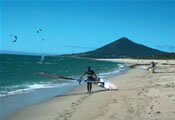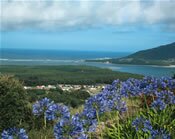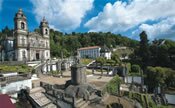Inflight Magazine of Brussels Airlines
Welcome to the Inflight Magazine of Brussels Airlines
Way out west
In their hurry to reach the sun-baked beaches of the Algarve, most tourists bypass the lush, green landscape that lines Portugal’s west coast, which suits Martin Symington just fine. Here he lets us in on his own slice of paradise
Images Alamy, Martin Symington, photolibrary.com
 If I had a bottle of vinho verde for every time I was asked by friends where to go on holiday in Portugal, my cellar would be overflowing. When my interlocutors are clearly dreaming of basking on beaches, I suggest they look no further than the Algarve. But sometimes their eyes light up at the suggestion that Portugal hides one of the most unspoilt corners of western Europe. This is when I bring up the Minho, the region between Porto and the Spanish border to the north, where I spent my childhood.
If I had a bottle of vinho verde for every time I was asked by friends where to go on holiday in Portugal, my cellar would be overflowing. When my interlocutors are clearly dreaming of basking on beaches, I suggest they look no further than the Algarve. But sometimes their eyes light up at the suggestion that Portugal hides one of the most unspoilt corners of western Europe. This is when I bring up the Minho, the region between Porto and the Spanish border to the north, where I spent my childhood.
A generation later, I return to the Minho as often as I can with my own family. These days the area is infinitely more prosperous, but it still hosts only a smattering of foreign tourists, a fraction of those who visit the beaches of the Algarve. Tourism officials like to call the region Costa Verde – the green, or emerald, coast, which is fair enough. The land – fragmented into myriad smallholdings of maize, vegetables and the ubiquitous vines growing on overhead trellises and even up trees – is kept lush and verdant by some of the highest rainfall in Europe.
 To the east, a backbone of craggy grey granite splattered with yellow lichen rises up from the coastal strip. Westwards, fields peter out into scrubby dunes and bald, Sahara-esque hills of marram grass and fine sand, ribbed by the north wind which can leave the sea cool, rough and angry. A surfing school at Praia de Afife attracts a young, goatee-sporting set from Porto, an hour’s drive south, but wetsuits are essential even at the height of summer. Increasingly, backpackers are also finding their way here, staying at one of several camp sites that nestle among the dunes, as word spreads of alluring tubes and rip curls, and superb conditions for kite surfing.
To the east, a backbone of craggy grey granite splattered with yellow lichen rises up from the coastal strip. Westwards, fields peter out into scrubby dunes and bald, Sahara-esque hills of marram grass and fine sand, ribbed by the north wind which can leave the sea cool, rough and angry. A surfing school at Praia de Afife attracts a young, goatee-sporting set from Porto, an hour’s drive south, but wetsuits are essential even at the height of summer. Increasingly, backpackers are also finding their way here, staying at one of several camp sites that nestle among the dunes, as word spreads of alluring tubes and rip curls, and superb conditions for kite surfing.
My base these days is a modern bungalow with a pool sheltered from the wind on a hillside overlooking the frontier town of Caminha, at the mouth of the Minho River. From here, we make sorties to the beaches of Moledo and Praia de Âncora, where my children revel in the elemental high drama of the huge, crashing waves. On other days, we make expeditions into the barren Serra de Arga, where there are rock pools and outcrops with commanding views over the sea and great swathes of coastline. These hills are deserted save for herds of wild ponies and the ruined São João d’Arga monastery. In other parts of Europe there would be turnstiles, tour guides and souvenir kiosks. Here, history seems to be lost among the weeds growing out of the cracks in the crumbling ramparts.
 The truth is, despite its expanses of sand, this area of coast will never offer the classic beach holiday. Instead, the region cries out to be explored. The Minho’s most historic towns, Guimarães and Braga, are prime targets for sightseeing. Guimarães, the first capital of Portugal, has an awesome castle where the new king was crowned in 1139. But on a recent visit it was Braga, Portugal’s ecclesiastical capital, that was the unexpected family hit. We spent a hot afternoon climbing the astonishing 600-step baroque staircase zigzagging its way to the pilgrimage sanctuary of Bom Jesus do Monte. Whimsical stone statues of biblical figures in turbans and cloaks sit at every turn. We cooled our heads under the fountain faces representing the five senses, including ones with water cascading from their noses, ears and mouths.
The truth is, despite its expanses of sand, this area of coast will never offer the classic beach holiday. Instead, the region cries out to be explored. The Minho’s most historic towns, Guimarães and Braga, are prime targets for sightseeing. Guimarães, the first capital of Portugal, has an awesome castle where the new king was crowned in 1139. But on a recent visit it was Braga, Portugal’s ecclesiastical capital, that was the unexpected family hit. We spent a hot afternoon climbing the astonishing 600-step baroque staircase zigzagging its way to the pilgrimage sanctuary of Bom Jesus do Monte. Whimsical stone statues of biblical figures in turbans and cloaks sit at every turn. We cooled our heads under the fountain faces representing the five senses, including ones with water cascading from their noses, ears and mouths.
But it’s not all piety in the Minho. On Thursdays, it’s worth getting up early to drive to Barcelos, where the largest weekly market in Portugal – some say in western Europe – is staged. By mid-morning, Barcelos – which is sedate and sleepy from Friday to Wednesday – is a hubbub of trading, with crates of chickens and rabbits, trucks of cattle, sheep and pigs, acres of cloth and endless ceramics stalls selling row upon row (more than there could possibly be customers for) of cherubic-looking pottery monks.
Away from the region’s cities and modern highways, you might get stuck behind the creaking wooden wheels of a bullock cart laden with maize on the narrow, winding lanes of the Minho’s interior. Whenever this happens to me, I think of it as an opportunity to pull over and explore my surroundings. There may be a spicy eucalyptus wood to walk through, or a track alongside a stream to an old stone footbridge, or a water mill where women meet to do the washing as they gossip or sing plaintive love songs.
 Or you might wander past a ramshackle farmhouse and admire the craftsmanship of the masons who have fashioned granite espigueiros (grain stores raised on stilts to prevent rats from getting in), which are usually topped with a stone cross. Then stop and smell the sweet, heady scent of the big, black, ripening grapes that dangle in huge bunches from the vines lining the roadsides.
Or you might wander past a ramshackle farmhouse and admire the craftsmanship of the masons who have fashioned granite espigueiros (grain stores raised on stilts to prevent rats from getting in), which are usually topped with a stone cross. Then stop and smell the sweet, heady scent of the big, black, ripening grapes that dangle in huge bunches from the vines lining the roadsides.
These are destined to be trodden into vinho verde, or ‘green wine’. The name refers not to the drink’s colour but to the fact that the wine is drunk young, sometimes only days after it has been made. Some is dry, white and spritzy (like the stuff that’s exported overseas). But what most people in the Minho drink is verde tinto (‘red green’) – actually a sort of deep, inky purple.
Just the smell of it is forcefully redolent of the Minho and, for this reason alone, it’s the stuff I would like a bottle of every time I am asked by my friends where they should go on holiday in Portugal.
FR Cap sur l’Ouest
Dans leur empressement à rejoindre les plages de l’Algarve, la plupart des touristes passent souvent à côté des paysages verdoyants qui bordent la côte ouest du Portugal… ce qui en fin de compte fait l’affaire de Martin Symington
Si je recevais une bouteille de vin chaque fois que mes amis me demandent où aller au Portugal, je n’aurais pas assez de place dans ma cave. Ils rêvent de plages ? Je leur suggère l’Algarve. Mais il m’arrive aussi de citer le Minho, la région qui se situe entre Porto et la frontière espagnole, au nord. On la désigne comme la Costa Verde, la côte verte, un qualificatif qui convient parfaitement à ce vert berceau du Portugal. Des précipitations abondantes – un des taux les plus élevés d’Europe – gardent à cette “costa” son paysage continuellement verdoyant.
Nous logeons souvent près de la ville de Caminha. De là, nous nous rendons vers les plages de Moledo et de Praia de Ancora. Et si le littoral n’offre pas de plages classiques au sens touristique du terme, la région recèle d’autres trésors qui ne demandent qu’à être explorés. Il y a ici Guimarães et Braga, deux villes joyaux qui sont de fantastiques buts de visite culturelle.
En quittant ces cités, vous emprunterez les petites routes sinueuses qui sillonnent la région. Si vous restez bloqués derrière une charrette, profitez-en pour bifurquer et sortir des sentiers battus. Qui sait ? Vous pourriez tomber sur une forêt d’eucalyptus, ou un chemin perdu bordant un cours d’eau. Ou encore, arrêtez-vous pour humer l’odeur exquise des grappes de raisins noirs qui se balancent sur les vignes, alignées le long de la route.
Ce sont les cépages qui produisent les vinhos verdes. Un nom qui fait référence à la fraîcheur de la jeunesse de ces vins plus qu’à leur couleur : ils sont en effet consommés dans leur prime jeunesse quelques jours parfois après leur fabrication. Certains sont blancs et pétillants, mais la plupart des habitants de la région de Minho boivent un verde tinto, un rouge foncé couleur pourpre. Voilà le vin que j’apprécierais chaque fois qu’un ami me demande où voyager au Portugal !
NL Het wonderlijke westen
De meeste toeristen laten het prachtige landschap aan de Portugese westkust links liggen in hun rush naar de stranden van de Algarve, en dat vindt Martin Symington prima
DAls ik een fles wijn zou krijgen per keer dat een van m’n vrienden me vraagt wat het mooiste plekje is in Portugal, zou mijn kelder overvol liggen. Als ze dromen van het strand, dan raad ik de Algarve aan. Maar soms breng ik Minho ter sprake, de streek tussen Porto en de grens met Spanje in het noorden. Sommige mensen noemen deze streek Costa Verde – de groene kust. Het is een perfecte beschrijving. Het landschap blijft er mooi groen dankzij de vele regenval, bijna het meeste van Europa.
We logeren vaak in het stadje Caminha. Het is dan onze uitvalsbasis voor uitstapjes naar de stranden Moledo en Praia de Ancora. Let wel, de kust zal hier nooit echt ideaal zijn voor een klassieke strandvakantie. De streek schreeuwt gewoon om verkend te worden. De oudste stadjes van Minho, Guimarães en Braga, zijn echte aanraders voor al wie houdt van een vleugje cultuur.
Wat verder weg van de steden is het goed mogelijk om achter een kar te belanden in de slingerende landwegen van de streek. Maak van de gelegenheid gebruik om je wagen even aan de kant te zetten en de omgeving te gaan verkennen. Wie weet vind je een eucalyptusbos vlakbij, of een pittoresk weggetje naast een kronkelende rivier. Ook de zoete geur van de dikke, zwarte druiven die aan tal van ranken langs de kant van de weg hangen, is een pitstop waard.
De druiven zijn voorbestemd om in vinho verde (groene wijn) te worden vertrappeld. De naam verwijst niet naar de kleur van de wijn maar naar het feit dat hij jong wordt gedronken, soms zelfs al een dag nadat hij geproduceerd wordt. Sommige varianten zijn droog, wit en bruisend, maar de meeste inwoners van Minho verkiezen de verde tinto, een dieppaarse, inktkleurige wijn. Weet je nog die fles die ik zou willen krijgen telkens mijn vrienden me vragen waar ze best heengaan in Portugal? Wel, doe mij maar zo’n heerlijke verde tinto!
Leave a Reply
